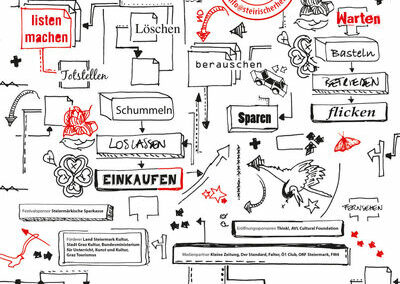A special role was played by the festival centres, designed by changing architects, located in ever different public places in Graz. This is where the herbst bar was located, where workshops, discussions, concerts and parties took place. In 2006 Stephen Craig redesigned the Künstlerhaus in the Stadtpark, the following year a temporary theatre was built on Karmeliterplatz, and in 2008 the festival centre moved into the empty Joanneum, and later a whole section of the street was used for performances.
Spielfeldforschung (playing field research) was established as the discursive program and theoretical backbone of the festival. This included the herbst academy, which usually extended over the entire festival period, the lecture and discussion series Open Up, as well as performative conferences that constantly tried out new formats, such as Dictionary of War (concept: Unfriendly Takeover / Multitude e. V., 2006), the Walking Conferences (concept: Florian Malzacher & Gesa Ziemer, 2006 & 07), the Trickster Conference (curated by Florian Malzacher & Sibylle Peters, 2010).
For the first time in 2006, a magazine was published to complement the programme booklet, herbst. Theorie zur Praxis, in which festival participants and other authors explored the respective themes in depth. From 2006 onwards, the festival also ran the virtual literary diary Randnotizen (marginal notes), for which participants from literature, the visual arts and net discourse acted as city writers, loggers and observers.
International attention has been paid in particular to own and co-productions in the fields of theatre, dance and performance with companies and artists such as Lola Arias, Anne Teresa De Keersmaeker, Tim Etchells, Forced Entertainment, Young Jean Lee, Lone Twin, Rabih Mroué, Nature Theater of Oklahoma, Rimini Protokoll, Meg Stuart, Gisèle Vienne and many others.
In 2012, steirischer herbst reacted to the rapid changes, crises and upheavals worldwide that gave rise to movements such as the Arab Spring or Occupy Wall Street with the 24/7 marathon camp Truth is concrete. Over 200 participants from art, science and activism – including the Colombian philosopher and politician Antanas Mockus, the theorist Chantal Mouffe and the radical Russian artist group Woina – analysed artistic strategies in politics and political strategies in art 24 hours a day for over a week. The camp on Opernring, consisting of various stages, working and living modules, library and exhibition space, was designed by raumlaborberlin. The publication Truth is Concrete: A Handbook for Artistic Strategies in Real Politics was published in 2014 to accompany this unique event in the framework of steirischer herbst.




